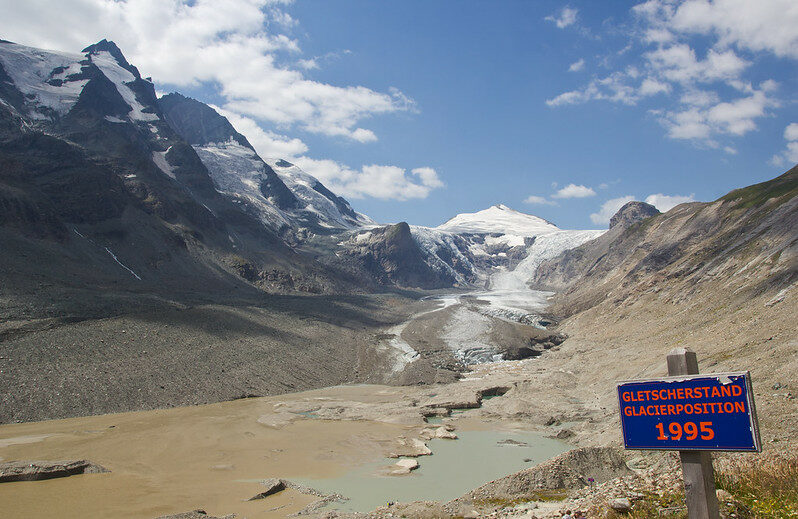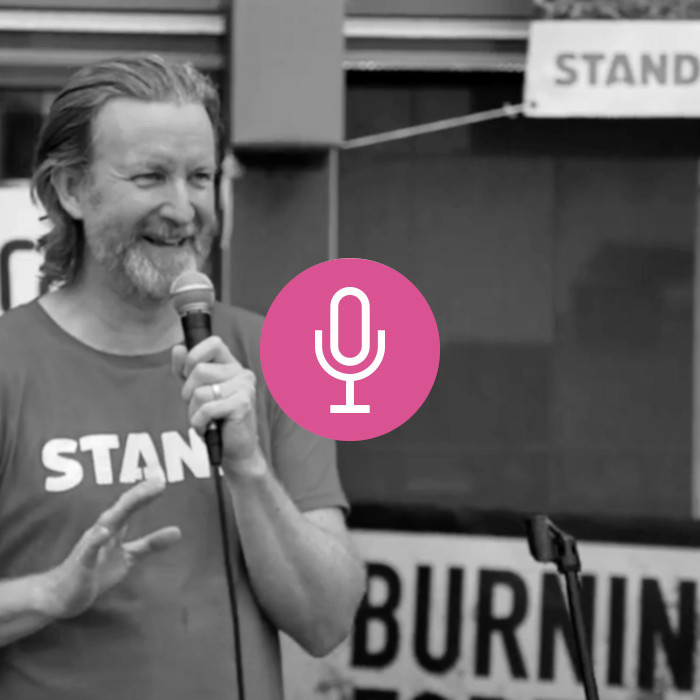Simon Mundy’s Race for Tomorrow gives the climate crisis a face – and a neck, and a body, and its own two legs, staggering into the room.
“Climate change” is not a graphic phrase. Type it into a photo bank to find wind turbines, trees, ice in various stages of the melting process, power plants, a facile cartoon of the Earth held in a human palm, and scrolling down further, a globe made of fire, in which all the continents are on fire, descending into a lake which is also on fire. Less than useful, less than inspiring.
In 2013, philosopher Timothy Morton came up with the theory of the Hyperobject, claiming that climate change is “so expansive that our understanding is continually outpaced by its total seepage into our environment. Climate change is both a thing and much more sign than a mere thing could ever be.” In other words, it’s too big to understand. Race for Tomorrow tackles this with a trek through 26 countries, meeting, among others, Mongolian cattle herders, Nigerian property developers, Bangladeshi shrimp farmers, the Saudi Arabian energy minister, Chilean winemakers, and communities in Ethiopia plagued by locusts and crocodiles.
All these encounters drive home a few key points: The Earth is such a finely tuned balance of ecosystems, that disruption to any constituent creates a butterfly effect of disaster; the world is saturated with so many different kinds of lives with opposing values, that changing either industry or consumption is never easy; the world is gorgeous and wonderful; the crisis is being shouldered by the poorest communities; climate action will be void until it is recognised as a human rights issue.
The IPCC excerpts littered throughout the book show that climate summits are not just distant, but extraterrestrial from the frontlines of the crisis. The statement “the number of climate migrants is projected to increase in all scenarios by 2050”, does nothing to suggest the childhood homes, first cars, second cars, dream cars, gardens, farms, classrooms, hairdressers, shops, playgrounds, galleries, places of worship, human lives swept away by the increased floods that section is referencing.
Yes, IPCC reports are not the place for human stories. But, when each report is released, there is an upsurge in Western media attention, decrying the need to reduce emissions, situating the frontiers of the climate crisis in the air, tackling what we can’t see, rather than defending people on the ground. Mundy isn’t the first to report on the human stories of the climate crisis, but the range of different lives he encounters gives a sense of its staggering scale.
A prime example of the butterfly effect of climate disaster is Ethiopia. Successive droughts were wreaking havoc on agriculture in that country. When, finally, rain came in 2020, the increased humidity drove a storm of locusts, who gorged themselves on crop supply. After they desecrated one farmed region, they’d move onto the next. Before leaving, they lined the fields with toxic faeces that killed grazing livestock after the locusts left. Elsewhere in the country, the rains burst the banks of the Shebelle river, flooding local areas, and enabling crocodiles to clamber on land, eating animals, and even people. The country’s agricultural sector was ravaged, and livelihoods were destroyed, drawing young men into the ranks of insurgent military group Al-Shabaab.
All over the world, defective political situations are made worse by climate change. Mundy travels to Eko Atlantic, a developing climate-resilient project in Nigeria, set to be complete in 2027. The settlement aims to protect Lagos’ Victoria Island against rising Atlantic sea levels. Its central boulevard is modelled on Paris’ Champs-Élysées, although Mundy says its closer to Naypyidaw, the sparsely populated capital city thrown up by Myanmar’s military junta in the 2000s. The artificial island is set to house 250,000 people. However, in a country where almost 60 per cent of the population live on less than a dollar a day, these luxury apartments will be homes for the super rich. Proof, as some see it, of a kind of climate “apartheid”.
In Bangladesh meanwhile, Mundy visits Gabura, a small island where groundwater is dangerously saline, thanks again to rising sea levels. The water is being further contaminated by shrimp farmers pumping waste brine water into the island’s interior lakes. Mundy interviews a local rice farmer, who blames the shrimp industry. “They get away with it because they’re rich enough to bribe the government people.” She says. “It’s because of them that we’re poor.”
Climate effects worsen as powerful people, businesses or governments evade responsibility. Ironically, it is the Saudi Arabian energy minister, Prince Abdulaziz bin Salman Al-Saud, who hits the nail on the head when he tells Mundy, ‘a politician is a politician: he would sell a pipe dream, because he’s not there in 2050, so he’s fine to throw the problem somewhere down the road.’
Whilst exposing so much lethal indifference, by exposing what’s at stake, Mundy shows you a world to really care about. Many stories in this book are a film directors dream, like the abandoned settlement of Moriusaq in Greenland. Once home to more than a hundred people, its population dwindled rapidly until only four hunters remained – one of whom was killed by the others in a gunfight. Or that 7,000 years ago, the Chinchorro people in Northern Chile used the dry conditions of the Atacama Desert to mummify their dead. There’s a beautiful passage on the marvel of coral spawning. Mundy interviews Mohamed Nasheed, a former Maldivian prime minister who spent 18 months in solitary confinement in his youth for activism against his country’s long-running dictatorship. In Bangladesh, there are communities known as tiger widows, women whose husbands were killed by tigers, who were then exiled by their communities as harbingers of bad luck. In Venice, Mundy describes the siren sounding from the Piazza San Marco in 2019, the tower where once Galileo demonstrated his telescope, raising the alarm that sea levels had risen to unforeseen levels, and would soon cover 90 per cent of the city’s land.
Race for Tomorrow does not demonise anyone, or present an unremittingly bleak picture of climate doom. Nothing about this issue is black and white. In Chile, changing temperatures have created conditions for vineyards, sparking a boom in the country’s wine industry. On the other hand, the rise of meat substitutes are now threatening the livelihoods of US animal farmers. In Greenland, the mining boom is culturally devastating, but financially advantageous. Mundy also looks into industries where ‘clean and green’ innovation has axed jobs. In Queensland (Australia), of the 2,350 people previously employed in the coal industry there, only 25 jobs remain, as a power plant is replaced by a giant battery to support the region’s shift to wind and solar. Climate action could often devastate communities which are built around the trade opportunities offered by their local environment. Who’s business is it to tell the cattle farmer to go vegan?
There is little mention in the book of the climate action and planned climate finance discussed at UN COPs. Mundy does touch on the African Great Green Wall Initiative, but only to point out where it has failed, and the difficulty in marshalling multilateral action when no one wants to take responsibility, and an initiative’s impact is rarely evaluated effectively. For most of the communities worst affected by the crisis, multilateral climate finance remains pie in the sky.
One of the book’s most powerful chapters is in Manila, where Mundy speaks with an activist about the day in 2012 when she escaped the typhoon which killed her family. He then interviews Roberto Cadiz, one of the country’s leading lawyers, who says that if a fraction of the harm caused by climate change was knowingly caused in any other context, the human rights case would be overwhelming.
I was reminded of the stat which recently went viral that if you had earned $50,000 a day since Jesus was born, you still would not have made as much as Shell did in profits last year. That’s crazy money, a hyper object in itself, made by one company. Race for Tomorrow shows you how expensive that is, and who’s really paying for it.
Race for Tomorrow by Simon Mundy was published in 2021 by Harper Collins and is available to buy in hardback for £20.
Lauren is an Assistant Editor at LCR. Her work has focused on geopolitics & climate policy, emissions solutions in the buildings sector, and reviews of new environment titles. Find her LinkedIn here, or email her at lauren@elc-insight.org
Read more:
- Bioeconomy, Culture, Removals





